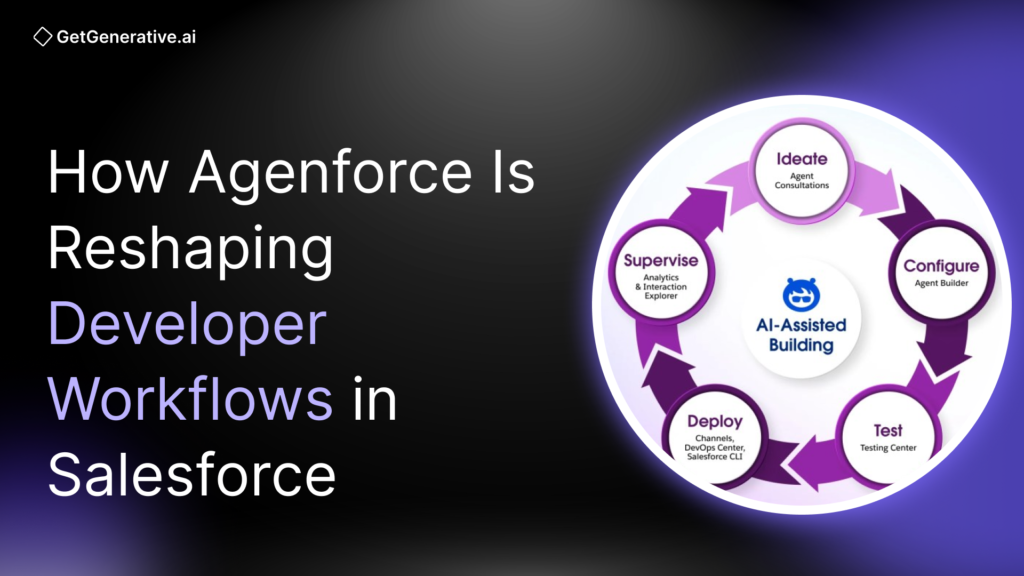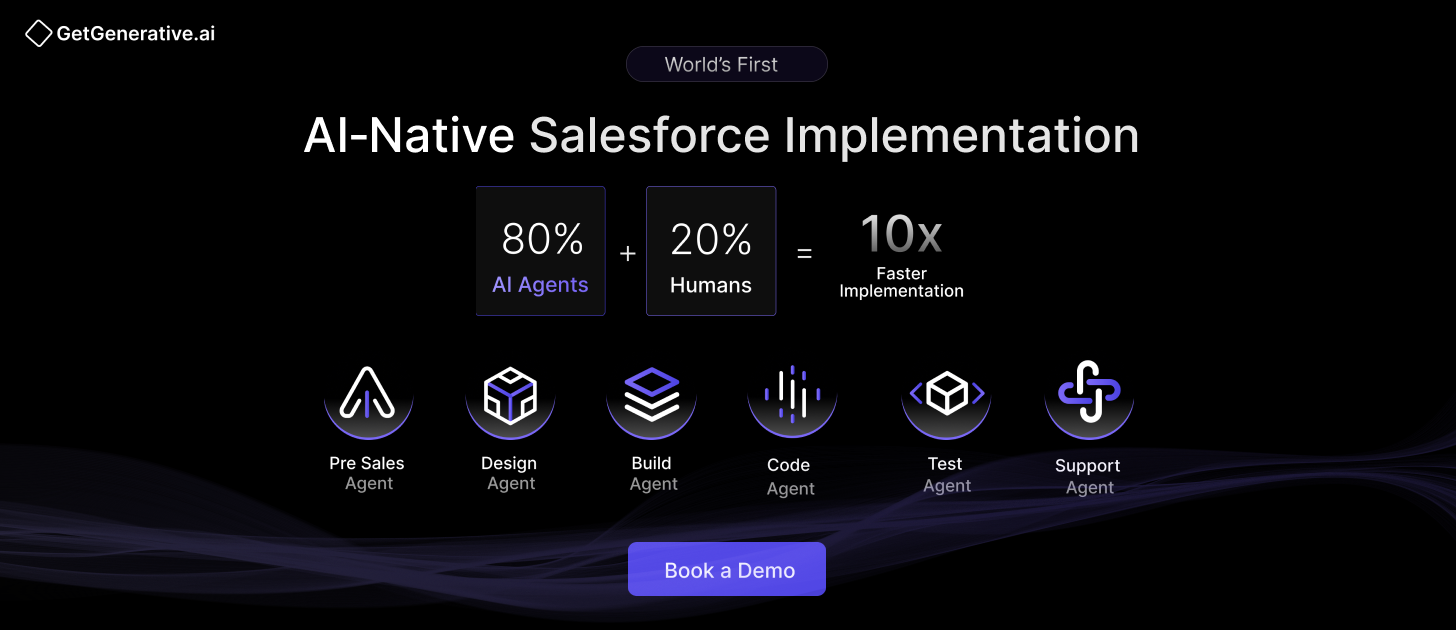How Agenforce Is Reshaping Developer Workflows in Salesforce
According to Salesforce, 96% of developers believe AI agents will improve the development experience, and 92% expect agentic AI to advance their careers.
In this blog, we explore how Agentforce is shaping modern development workflows, starting with the underlying platform, the tooling available for developers, and the real-world productivity gains. Let’s get started!
What is Agentforce?
Agentforce is Salesforce’s native AI agent framework that enables the creation of intelligent, autonomous agents directly within the CRM ecosystem. These agents are powered by generative AI and real-time data, allowing them to perform tasks, interact with systems, and make decisions with minimal human input.
Unlike traditional rule-based automation, Agentforce agents are grounded in context through Salesforce Data Cloud and can take complex actions using Apex, Flows, and APIs.
Why Developers Should Care
Agentforce isn’t a standalone product—it’s embedded into the Salesforce stack. Developers don’t need to learn a new language or adopt a separate toolchain. Instead, Agentforce allows the reuse of existing metadata, Apex code, flows, and APIs to define agent behavior. This tight integration means developers can focus on orchestrating logic rather than writing it from scratch.
Salesforce’s FY2025 report highlights Agentforce’s strategic importance, attributing $900 million in ARR and 3,000 net-new Agentforce deals in Q4 2024 to its adoption. Moreover, companies like Wiley Education reported 40% higher case resolution rates when switching from bots to Agentforce-powered agents.
Marc Benioff called Agentforce the enabler of an “on-demand digital workforce.” For Salesforce developers, it’s a leap toward automation without sacrificing the control and governance required in enterprise-grade environments.
Agentforce for Developers
To bring AI directly to developers’ fingertips, Salesforce released Agentforce for Developers, a set of intelligent coding tools embedded within VS Code and Code Builder. At the heart of this suite is a generative AI model (CodeGen2.5 and SFR Code model) that can interpret natural language, understand Apex syntax, and offer context-aware assistance in real time.
Key Features:
Natural Language Code Generation
With Agentforce’s Dev Extension, you can describe the functionality you want in plain English, and the system will generate Apex classes, triggers, or LWC code. For example:
“Generate an Apex trigger that updates an Account field when a related Contact is changed.”
Inline Auto-Completion
Agentforce surfaces intelligent auto-completions as you type Apex or JavaScript. These suggestions reduce errors, save keystrokes, and standardize coding patterns across your team. It’s like GitHub Copilot, but fine-tuned for Salesforce’s ecosystem.
Interactive Dev Assistant
A conversational panel allows developers to:
- Ask questions about unfamiliar code
- Generate unit tests with slash commands like /test
- Produce inline documentation
- Refactor and explain complex logic
All outputs are based on anonymized Salesforce code patterns. Importantly, your proprietary code is not used to train Salesforce’s AI models, preserving IP and confidentiality.
Why It Matters
Salesforce emphasizes that this tooling “boosts productivity and simplifies complex tasks.” For senior developers, it shortens iteration cycles. For junior developers, it’s a built-in mentor.
In developer research presented at Dreamforce, respondents listed the following as the most valuable AI use cases:
- Test generation (84%)
- Code review assistance (76%)
- Debugging support (69%)
Agentforce for Developers delivers on all three.
Also Read – Agentforce for Developers: How to Build AI-Powered Solutions
Agentforce DX: Building Agents with Pro-Code Workflows
While Agentforce started with a low-code visual builder, pro developers now have Agentforce DX—a CLI- and YAML-based framework that embeds agent creation directly into developer workflows.
Key Capabilities
CLI Integration
A new plugin for Salesforce CLI lets you:
- Generate agent specs via sf agent generate agent-spec
- Preview agent interactions
- Deploy agents across environments
This allows agent configurations to be stored in Git, version-controlled, peer-reviewed, and CI-tested, just like Apex classes or Lightning Web Components.
YAML-Based Metadata
Agent definitions are now expressed in human-readable YAML, including:
- Agent topics and intents
- Guardrails and constraints
- API and Flow references
- Test cases and expected responses
This shift from XML to YAML makes it easy to read, diff, and merge changes. It also supports GitOps and Infrastructure-as-Code models for AI agents.
Conversation Simulation
Developers can write and execute agent tests using YAML, similar to unit tests. This ensures agents respond correctly under various conditions and edge cases, without requiring them to be deployed first.
DevOps Alignment: CI/CD for Agents
Agentforce DX was designed with DevOps in mind. Developers can now:
- Include agent specs in their Git repos
- Add agent tests to CI pipelines
- Auto-deploy agents to sandboxes or production with release branches
This means no more switching back and forth between browser builders and local environments. Teams can manage agents with the same maturity and discipline as any other application artifact.
Developer Productivity Gains: Real-World Impact
So what’s the bottom-line benefit?
Accelerated Build Cycles
Customers like Secret Escapes reduced AI agent build time from 6 months to 2 weeks using Agentforce—an 85% time savings.
Reduced Repetition
Tasks like:
- Generating Apex tests
- Writing boilerplate triggers
- Drafting user prompts and flows
…are now handled automatically, allowing developers to focus on architectural design and optimization.
Enhanced Developer Experience
Agentforce removes friction in daily dev work. As one Salesforce product lead noted:
“Developers spend less time configuring and more time creating.”
This shift unlocks more engaging work and aligns technical tasks with strategic outcomes. In developer surveys, 92% said Agentforce would help them advance in their careers.
Also Read – Everything You Need to Know to Implement Salesforce Agentforce in 2025
Deep Integration with Salesforce Data Cloud
A key advantage of Agentforce is its native integration with the Salesforce platform, particularly with Data Cloud, formerly known as Customer 360 Audiences. This gives Agentforce agents deep contextual awareness grounded in real customer and enterprise data.
Reuse Existing Assets
Agentforce doesn’t require developers to reinvent the wheel. You can:
- Trigger existing Apex classes or Flows as agent actions.
- Call external APIs defined in your org.
- Use Salesforce prompt templates and metadata directly within agents.
Data Cloud as Agent Brain
Behind Agentforce is Data Cloud, Salesforce’s hyper-scalable data engine that unifies structured and unstructured data across the enterprise. This allows agents to:
- Ground responses in live customer profiles
- Avoid hallucinations by referencing past case histories
- Connect to external data sources like Snowflake, Databricks, or MuleSoft APIs
By tapping into Data Cloud, agents become smarter and more reliable—no generic answers, just context-rich, accurate assistance.
Developer Responsibility
Because Agentforce relies heavily on enterprise data, developers play a key role in:
- Defining which Data Cloud datasets an agent can access
- Setting up grounding rules and filters
- Auditing what information agents use to reason and act
In most organizations, this requires close collaboration with data engineers, architects, and security teams to ensure data accuracy, access control, and compliance.
Governance, Security, and the Einstein Trust Layer
With AI agents acting on behalf of users, governance is critical. Salesforce has implemented robust protections via its Einstein Trust Layer, designed to enforce security, privacy, and compliance.
Key Trust Layer Features
- Zero data retention: Customer prompts and agent responses aren’t stored or used to train Salesforce’s models.
- Grounding filters: Limit what an agent can “see” to reduce risk of hallucinations or data leaks.
- Toxic content filtering: Prevent agents from generating inappropriate or biased content.
- Audit trails and logs: Every action taken by an agent is logged and reviewable.
These features let developers build with confidence. As emphasized in Salesforce’s Trust Center, Agentforce aligns with enterprise-grade data policies, including SOC 2, ISO 27001, and GDPR.
Dev Role in Trust & Compliance
Developers must:
- Configure security guardrails (e.g., which actions are allowed)
- Validate agent outputs with test simulations
- Participate in reviews for AI-driven features
This governance-first approach helps ensure Agentforce agents are safe, ethical, and audit-ready from the start.
Post-Deployment Monitoring & Analytics
Agentforce provides tools to track agent behavior and enhance performance over time, transforming agent deployment into a continuous learning loop.
Interaction Explorer
This dashboard lets teams:
- Review real-time agent conversations
- Identify bottlenecks or logic errors
- Spot trends in agent usage and outcomes
If an agent frequently provides incorrect info or fails to complete tasks, developers can trace the issue to flawed logic, missing data, or unclear instructions and fix it directly in YAML or Flow.
Continuous Feedback Loop
Best practice:
- Build: Define agent topics, actions, and guardrails
- Test: Use simulation tools or scripted conversations
- Deploy: Push to sandbox, UAT, or production
- Monitor: Use built-in analytics to assess performance
- Refine: Iterate quickly based on real-world results
By treating agents like living software components, teams maintain quality and relevance over time.
Final Thoughts
Agentforce doesn’t just offer faster development—it redefines the role of a Salesforce developer. Engineers are no longer just coders; they’re architects of intelligent systems.
At GetGenerative.ai, we’ve reimagined Salesforce implementation—built from the ground up with AI at the core. This isn’t legacy delivery with AI added on. It’s a faster, smarter, AI-native approach powered by our proprietary platform.
👉 Explore our Salesforce AI consulting services




